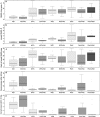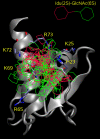Docking glycosaminoglycans to proteins: analysis of solvent inclusion
- PMID: 21597992
- PMCID: PMC3107433
- DOI: 10.1007/s10822-011-9433-1
Docking glycosaminoglycans to proteins: analysis of solvent inclusion
Abstract
Glycosaminoglycans (GAGs) are anionic polysaccharides, which participate in key processes in the extracellular matrix by interactions with protein targets. Due to their charged nature, accurate consideration of electrostatic and water-mediated interactions is indispensable for understanding GAGs binding properties. However, solvent is often overlooked in molecular recognition studies. Here we analyze the abundance of solvent in GAG-protein interfaces and investigate the challenges of adding explicit solvent in GAG-protein docking experiments. We observe PDB GAG-protein interfaces being significantly more hydrated than protein-protein interfaces. Furthermore, by applying molecular dynamics approaches we estimate that about half of GAG-protein interactions are water-mediated. With a dataset of eleven GAG-protein complexes we analyze how solvent inclusion affects Autodock 3, eHiTs, MOE and FlexX docking. We develop an approach to de novo place explicit solvent into the binding site prior to docking, which uses the GRID program to predict positions of waters and to locate possible areas of solvent displacement upon ligand binding. To investigate how solvent placement affects docking performance, we compare these results with those obtained by taking into account information about the solvent position in the crystal structure. In general, we observe that inclusion of solvent improves the results obtained with these methods. Our data show that Autodock 3 performs best, though it experiences difficulties to quantitatively reproduce experimental data on specificity of heparin/heparan sulfate disaccharides binding to IL-8. Our work highlights the current challenges of introducing solvent in protein-GAGs recognition studies, which is crucial for exploiting the full potential of these molecules for rational engineering.
Figures




Similar articles
-
Computational Analysis of Solvent Inclusion in Docking Studies of Protein-Glycosaminoglycan Systems.Methods Mol Biol. 2018;1762:445-454. doi: 10.1007/978-1-4939-7756-7_22. Methods Mol Biol. 2018. PMID: 29594785
-
Coarse-grained model of glycosaminoglycans.J Chem Inf Model. 2015 Jan 26;55(1):114-24. doi: 10.1021/ci500669w. Epub 2014 Dec 19. J Chem Inf Model. 2015. PMID: 25490039
-
Flexibility and explicit solvent in molecular-dynamics-based docking of protein-glycosaminoglycan systems.J Chem Inf Model. 2014 Feb 24;54(2):582-92. doi: 10.1021/ci4006047. Epub 2014 Feb 12. J Chem Inf Model. 2014. PMID: 24479827
-
The structure of glycosaminoglycans and their interactions with proteins.Chem Biol Drug Des. 2008 Dec;72(6):455-82. doi: 10.1111/j.1747-0285.2008.00741.x. Chem Biol Drug Des. 2008. PMID: 19090915 Review.
-
Glycomics approach to structure-function relationships of glycosaminoglycans.Annu Rev Biomed Eng. 2006;8:181-231. doi: 10.1146/annurev.bioeng.8.061505.095745. Annu Rev Biomed Eng. 2006. PMID: 16834555 Review.
Cited by
-
Ligand binding to anti-cancer target CD44 investigated by molecular simulations.J Mol Model. 2016 Jul;22(7):165. doi: 10.1007/s00894-016-3029-6. Epub 2016 Jun 24. J Mol Model. 2016. PMID: 27342250
-
In-Depth Molecular Dynamics Study of All Possible Chondroitin Sulfate Disaccharides Reveals Key Insight into Structural Heterogeneity and Dynamism.Biomolecules. 2022 Jan 5;12(1):77. doi: 10.3390/biom12010077. Biomolecules. 2022. PMID: 35053225 Free PMC article.
-
Syntheses of defined sulfated oligohyaluronans reveal structural effects, diversity and thermodynamics of GAG-protein binding.Chem Sci. 2018 Nov 1;10(3):866-878. doi: 10.1039/c8sc03649g. eCollection 2019 Jan 21. Chem Sci. 2018. PMID: 30774881 Free PMC article.
-
Docking server for the identification of heparin binding sites on proteins.J Chem Inf Model. 2014 Jul 28;54(7):2068-78. doi: 10.1021/ci500115j. Epub 2014 Jul 10. J Chem Inf Model. 2014. PMID: 24974889 Free PMC article.
-
Combinatorial Virtual Library Screening Study of Transforming Growth Factor-β2-Chondroitin Sulfate System.Int J Mol Sci. 2021 Jul 14;22(14):7542. doi: 10.3390/ijms22147542. Int J Mol Sci. 2021. PMID: 34299163 Free PMC article.
References
-
- Jackson R, Busch S, Cardin A. Glycosaminoglycans: molecular properties, protein interactions, and role in physiological processes. Phys Rev. 1991;71:481–539. - PubMed
-
- Angulo J, Ojeda R, de Paz J, Lucas R, Nieto P, Lozano R, Redondo-Horcajo M, Giménez-Gallego G, Martín-Lomas M (2004) The activation of fibroblast growth factors (FGFs) by Glycosaminoglycans: influence of the sulfation pattern on the biological activity of FGF-1. Chem Bio Chem 5:55–61 - PubMed
Publication types
MeSH terms
Substances
LinkOut - more resources
Full Text Sources
Other Literature Sources

